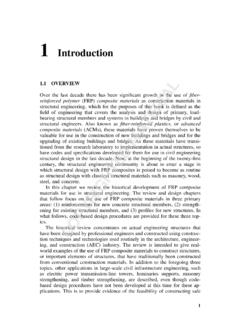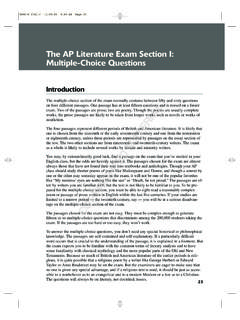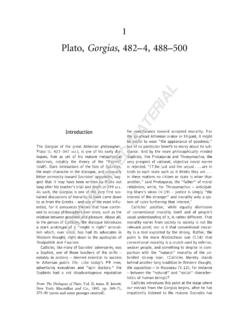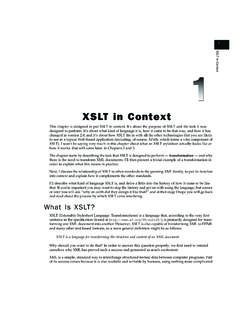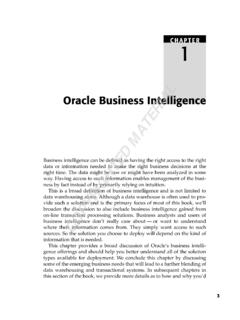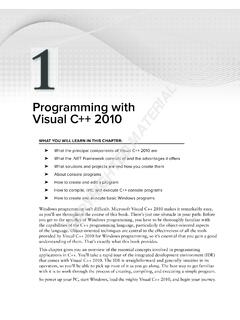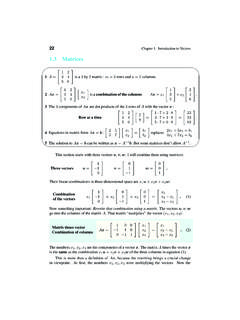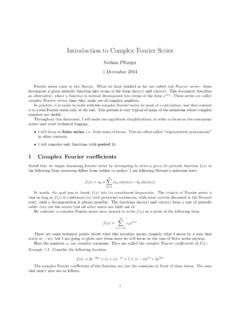Transcription of Introduction to Big Data Analytics - Wiley
1 1 Introduction to big data AnalyticsKey ConceptsBig data overviewState of the practice in analyticsBusiness Intelligence versus data ScienceKey roles for the new big data ecosystemThe data ScientistExamples of big data analyticsCOPYRIGHTED MATERIAL2 Introduction to big data analytIcsMuch has been written about big data and the need for advanced Analytics within industry, academia, and government. Availability of new data sources and the rise of more complex analytical opportunities have created a need to rethink existing data architectures to enable Analytics that take advantage of big data . In addition, significant debate exists about what big data is and what kinds of skills are required to make best use of it. This chapter explains several key concepts to clarify what is meant by big data , why advanced Analytics are needed, how data Science differs from Business Intelligence (BI), and what new roles are needed for the new big data big data overviewData is created constantly, and at an ever-increasing rate.
2 Mobile phones, social media, imaging technologies to determine a medical diagnosis all these and more create new data , and that must be stored somewhere for some purpose. Devices and sensors automatically generate diagnostic information that needs to be stored and processed in real time. Merely keeping up with this huge influx of data is difficult, but substan-tially more challenging is analyzing vast amounts of it, especially when it does not conform to traditional notions of data structure, to identify meaningful patterns and extract useful information. These challenges of the data deluge present the opportunity to transform business, government, science, and everyday industries have led the way in developing their ability to gather and exploit data : Credit card companies monitor every purchase their customers make and can identify fraudulent purchases with a high degree of accuracy using rules derived by processing billions of transactions. Mobile phone companies analyze subscribers calling patterns to determine, for example, whether a caller s frequent contacts are on a rival network.
3 If that rival network is offering an attractive promo-tion that might cause the subscriber to defect, the mobile phone company can proactively offer the subscriber an incentive to remain in her contract. For companies such as LinkedIn and Facebook, data itself is their primary product. The valuations of these companies are heavily derived from the data they gather and host, which contains more and more intrinsic value as the data attributes stand out as defining big data characteristics: Huge volume of data : Rather than thousands or millions of rows, big data can be billions of rows and millions of columns. Complexity of data types and structures: big data reflects the variety of new data sources, formats, and structures, including digital traces being left on the web and other digital repositories for subse-quent analysis. Speed of new data creation and growth: big data can describe high velocity data , with rapid data ingestion and near real time the volume of big data tends to attract the most attention, generally the variety and veloc-ity of the data provide a more apt definition of big data .
4 ( big data is sometimes described as having 3 Vs: volume, variety, and velocity.) Due to its size or structure, big data cannot be efficiently analyzed using only traditional databases or methods. big data problems require new tools and technologies to store, manage, and realize the business benefit. These new tools and technologies enable creation, manipulation, and big data overview3management of large datasets and the storage environments that house them. Another definition of big data comes from the McKinsey Global report from 2011: big data is data whose scale, distribution, diversity, and/or timeliness require the use of new technical architectures and Analytics to enable insights that unlock new sources of business big data : The Next Frontier for Innovation, Competition, and P r o du c t iv it y [1]McKinsey s definition of big data implies that organizations will need new data architectures and ana-lytic sandboxes, new tools, new analytical methods, and an integration of multiple skills into the new role of the data scientist, which will be discussed in Section Figure 1-1 highlights several sources of the big data 1-1 What s driving the data delugeThe rate of data creation is accelerating, driven by many of the items in Figure media and genetic sequencing are among the fastest-growing sources of big data and examples of untraditional sources of data being used for example, in 2012 Facebook users posted 700 status updates per second worldwide, which can be leveraged to deduce latent interests or political views of users and show relevant ads.
5 For instance, an update in which a woman changes her relationship status from single to engaged would trigger ads on bridal dresses, wedding planning, or name-changing can also construct social graphs to analyze which users are connected to each other as an interconnected network. In March 2013, Facebook released a new feature called Graph Search, enabling users and developers to search social graphs for people with similar interests, hobbies, and shared Introduction to big data analytIcsAnother example comes from genomics. Genetic sequencing and human genome mapping provide a detailed understanding of genetic makeup and lineage. The health care industry is looking toward these advances to help predict which illnesses a person is likely to get in his lifetime and take steps to avoid these maladies or reduce their impact through the use of personalized medicine and treatment. Such tests also highlight typical responses to different medications and pharmaceutical drugs, heightening risk awareness of specific drug data has grown, the cost to perform this work has fallen dramatically.
6 The cost to sequence one human genome has fallen from $100 million in 2001 to $10,000 in 2011, and the cost continues to drop. Now, websites such as 23andme (Figure 1-2) offer genotyping for less than $100. Although genotyping analyzes only a fraction of a genome and does not provide as much granularity as genetic sequencing, it does point to the fact that data and complex analysis is becoming more prevalent and less expensive to 1-2 Examples of what can be learned through genotyping, from big data overview5As illustrated by the examples of social media and genetic sequencing, individuals and organizations both derive benefits from analysis of ever-larger and more complex datasets that require increasingly powerful analytical data StructuresBig data can come in multiple forms, including structured and non-structured data such as financial data , text files, multimedia files, and genetic mappings. Contrary to much of the traditional data analysis performed by organizations, most of the big data is unstructured or semi-structured in nature, which requires different techniques and tools to process and analyze.
7 [2] Distributed computing environments and massively parallel processing (MPP) architectures that enable parallelized data ingest and analysis are the preferred approach to process such complex this in mind, this section takes a closer look at data 1-3 shows four types of data structures, with 80 90% of future data growth coming from non-structured data types. [2] Though different, the four are commonly mixed. For example, a classic Relational Database Management System (RDBMS) may store call logs for a software support call center. The RDBMS may store characteristics of the support calls as typical structured data , with attributes such as time stamps, machine type, problem type, and operating system. In addition, the system will likely have unstructured, quasi- or semi-structured data , such as free-form call log information taken from an e-mail ticket of the problem, customer chat history, or transcript of a phone call describing the technical problem and the solu-tion or audio file of the phone call conversation.
8 Many insights could be extracted from the unstructured, quasi- or semi-structured data in the call center 1-3 big data Growth is increasingly unstructured6 Introduction to big data analytIcsAlthough analyzing structured data tends to be the most familiar technique, a different technique is required to meet the challenges to analyze semi-structured data (shown as XML), quasi-structured (shown as a clickstream), and unstructured are examples of how each of the four main types of data structures may look. Structured data : data containing a defined data type, format, and structure (that is, transaction data , online analytical processing [OLAP] data cubes, traditional RDBMS, CSV files, and even simple spread-sheets). See Figure 1- 4 Example of structured data Semi-structured data : Textual data files with a discernible pattern that enables parsing (such as Extensible Markup Language [XML] data files that are self-describing and defined by an XML schema).
9 See Figure 1-5. Quasi-structured data : Textual data with erratic data formats that can be formatted with effort, tools, and time (for instance, web clickstream data that may contain inconsistencies in data values and formats). See Figure 1-6. Unstructured data : data that has no inherent structure, which may include text documents, PDFs, images, and video. See Figure big data overview7 Quasi-structured data is a common phenomenon that bears closer scrutiny. Consider the following example. A user attends the EMC World conference and subsequently runs a Google search online to find information related to EMC and data Science. This would produce a URL such as .com/#q=EMC+ data +science and a list of results, such as in the first graphic of Figure 1-5 Example of semi-structured dataAfter doing this search, the user may choose the second link, to read more about the headline data Scientist EMC Education, Training, and Certification. This brings the user to an site focused on this topic and a new URL, 8 Introduction to big data , that displays the page shown as (2) in Figure 1-6.
10 Arriving at this site, the user may decide to click to learn more about the process of becoming certified in data science. The user chooses a link toward the top of the page on Certifications, bringing the user to a new URL: , which is (3) in Figure these three websites adds three URLs to the log files monitoring the user s computer or network use. These three URLs are: #q=EMC+ data + 1- 6 Example of EMC data Science search big data overview9 FIgure 1-7 Example of unstructured data : video about Antarctica expedition [3]This set of three URLs reflects the websites and actions taken to find data Science information related to EMC. Together, this comprises a clickstream that can be parsed and mined by data scientists to discover usage patterns and uncover relationships among clicks and areas of interest on a website or group of four data types described in this chapter are sometimes generalized into two groups: structured and unstructured data . big data describes new kinds of data with which most organizations may not be used to working.
